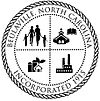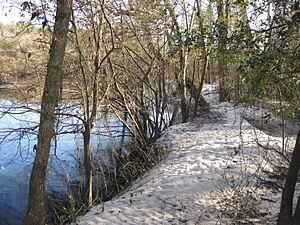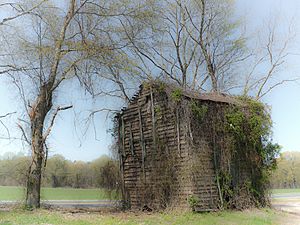Beulaville, North Carolina facts for kids
Quick facts for kids
Beulaville, North Carolina
|
||
|---|---|---|
|
||
| Motto(s):
"A Place to Come Home To"
|
||
| Country | United States | |
| State | North Carolina | |
| County | Duplin | |
| Area | ||
| • Total | 1.55 sq mi (4.00 km2) | |
| • Land | 1.54 sq mi (4.00 km2) | |
| • Water | 0.00 sq mi (0.00 km2) | |
| Elevation | 82 ft (25 m) | |
| Population
(2020)
|
||
| • Total | 1,116 | |
| • Density | 722.33/sq mi (278.93/km2) | |
| Time zone | UTC-5 (Eastern (EST)) | |
| • Summer (DST) | UTC-4 (EDT) | |
| ZIP code |
28518
|
|
| Area codes | 910, 472 | |
| FIPS code | 37-05660 | |
| GNIS feature ID | 2405259 | |
Beulaville is a town in Duplin County, North Carolina, United States. In 2020, about 1,116 people lived there. The town is part of the Limestone Creek area.
Contents
History of Beulaville
Early Native American Life
The first people to live in this area were Native Americans. The Joara tribe, who lived around the year 1000, were one of the earliest groups. They were a powerful group from the Mississippian culture.
Before Europeans arrived in the early 1700s, many Native American tribes lived in coastal North Carolina. These included the Coree, Coharie, Neusiok, and Tuscarora tribes. The Tuscarora became the strongest tribe. Smaller tribes often joined them for safety. The Tuscarora used the forests of eastern Duplin County for hunting.
You can find many Native American burial mounds in Duplin County, especially near Beulaville. There are four large mounds within ten miles of the town. The two biggest are near Hallsville and Sarecta. These mounds hold about one hundred bodies.
European Settlers Arrive
When people from Europe, like the Palatines, English, and Welsh, started settling in North Carolina, it led to the Tuscarora War (1710–1715). After this war, the Tuscarora tribe moved to New York. This opened up the land for more European settlers. Many of the first European settlers in Beulaville came from nearby counties like Jones, Onslow, Beaufort, and Craven.
In 1736, many Scotch-Irish and some Swiss Protestants came to what is now Duplin County. They settled on a large piece of land between the Northeast Cape Fear River and Black River. Their first settlements were Sarecta and an area near Goshen Swamp. By the mid-1800s, some families from these early settlements moved to the crossroads that would become Beulaville.
Beulaville was first called "Snatchet" in 1873. It became a trading center for farmers and people working in logging and making turpentine. Locals sometimes called it "Tearshirt" because there were often fights in the streets. Making and selling homemade alcohol was a common way for families to earn money for a long time. When an old building downtown was torn down, a hidden place for making alcohol and several barrels were found in the basement!
Around 1900, a railway was built from Kinston to Pink Hill. In 1916, people in the Beulaville area raised money to extend this railway through Beulaville and Chinquapin. This railway, which ran along what is now Railroad Street, is no longer there. The town's post office officially changed its name to "Beulaville" in 1910. The town was officially recognized five years later. Beulaville got its name from the Beulah Baptist Church, which is now called Beulaville Baptist Church. Beulaville is the newest town to be officially recognized in Duplin County.
Education in Beulaville
In 1839, Duplin County started a tax to create public schools. Around 1870, the first public school in Beulaville was built. It was a small wooden cabin with only one teacher. By 1901, there were four teachers. In 1906, land was bought for a new school. A new two-story wooden building opened in 1917-1918, with almost 200 students. More buildings, like an auditorium and gym, were added later.
On November 6, 1945, the main school building burned down. Only the gym and auditorium were saved. School continued in these buildings until 1947, when new elementary and high school buildings were built. In 1960, Potter's Hill Elementary joined Beulaville. Soon after, schools became integrated, meaning students of all races could attend together.
Today, Beulaville has one elementary and middle school called Beulaville Elementary. It also has one high school, East Duplin High School. The mascot for both schools is the panther. This refers to the eastern cougar, which used to live in the swamps and forests of eastern North Carolina. East Duplin High School was built in 1963. It combines students from Beulaville, B. F. Grady, and Chinquapin elementary schools.
Geography of Beulaville
Beulaville is located on the coastal plain of North Carolina, in Duplin County. It is about 85 feet (26 meters) above sea level. The land is mostly flat. Limestone Creek, a small stream that flows into the Northeast Cape Fear River, is on the western side of town. Beulaville is about 90 miles (145 km) southeast of Raleigh and 312 miles (502 km) south of Washington, D.C..
The town covers an area of about 1.5 square miles (4.0 square kilometers). All of this area is land.
People of Beulaville (Demographics)
| Historical population | |||
|---|---|---|---|
| Census | Pop. | %± | |
| 1880 | 32 | — | |
| 1890 | 51 | 59.4% | |
| 1920 | 354 | — | |
| 1930 | 494 | 39.5% | |
| 1940 | 567 | 14.8% | |
| 1950 | 724 | 27.7% | |
| 1960 | 1,062 | 46.7% | |
| 1970 | 1,156 | 8.9% | |
| 1980 | 1,060 | −8.3% | |
| 1990 | 933 | −12.0% | |
| 2000 | 1,067 | 14.4% | |
| 2010 | 1,296 | 21.5% | |
| 2020 | 1,116 | −13.9% | |
| U.S. Decennial Census | |||
What the 2020 Census Shows
| Race | Number | Percentage |
|---|---|---|
| White (non-Hispanic) | 684 | 61.29% |
| Black or African American (non-Hispanic) | 278 | 24.91% |
| Native American | 9 | 0.81% |
| Asian | 6 | 0.54% |
| Other/Mixed | 47 | 4.21% |
| Hispanic or Latino | 92 | 8.24% |
In 2020, there were 1,116 people living in Beulaville. There were 748 households and 388 families in the town.
Fun Things to Do in Beulaville
Beulaville is located about 4 miles (6.4 km) east of the Northeast Cape Fear River. This means there are many outdoor activities to enjoy. There are two places to launch boats on the Northeast Cape Fear River within 7 miles (11 km) of town. One used to be a public spot in Hallsville, but it is now closed. The other is west of Beulaville, off Highway 24. You can also find several golf courses near Beulaville and in the larger Duplin area.
Within Beulaville, there are three public parks. One is the William Ray Humphrey Athletic Park. This park used to be the elementary school's sports fields. It is located behind the Beulaville Municipal Complex. It has three baseball fields, two tennis courts, two outdoor basketball courts, and an indoor gym called the John Hargett Gymnasium.
About 5 miles (8 km) north of Beulaville, you can visit Cabin Lake County Park. This park is 167 acres (67.6 hectares) and offers camping, canoeing, and hiking all year round. Also, about 7 miles (11 km) southeast of Beulaville, you can find the Tarkil Branch Farm Museum at Cedar Fork. This museum has a real 1830s farm with over 850 old items. It is located on a 375-acre (152-hectare) working farm.
Beulaville's Economy
In the past, the main businesses for families in the Beulaville area were making "naval stores" (like tar and pitch from trees) and cutting lumber. These products were sent down the Northeast Cape Fear River to Wilmington. When the demand for naval stores went down, people started growing corn and, most importantly, tobacco.
As many small tobacco farms closed, the area needed new ways to make money. Raising hogs became very important. Today, farming is still a big part of Beulaville's economy. Duplin County has the second-highest number of hogs compared to people in the country! However, service jobs (like in stores and restaurants) and factory jobs are slowly becoming more common. Growing grapes for wine has also increased in the area.
The North Carolina Global TransPark is a large industrial airport about 30 miles (48 km) north in Kinston. This is a good thing for businesses looking to move to the area. Beulaville also benefits from being close to Marine Corps Base Camp Lejeune, which is about 35 miles (56 km) southeast. This brings more traffic through town and offers job chances for people living in Beulaville.
Major Employers Nearby
| Company | Industry | Number of Employees (countywide) |
|---|---|---|
| Butterball, LLC | Manufacturing (making things) | 1000+ |
| Smithfield Foods, Inc | Manufacturing | 1000+ |
| Duplin County Schools | Education | 1000+ |
| House of Raeford, Inc | Manufacturing | 1000+ |
| Guilford Mills, Inc | Manufacturing | 500-999 |
| County of Duplin | Government | 500-999 |
| Murphy Family Ven. | Natural Resources (farming, etc.) | 500-999 |
| James Sprunt CC | Education | 250-499 |
| Eastpointe Human Services | Healthcare Services | 100-249 |
| Goshen Medical | Health Services | 100-249 |
| Superior Metal Structures & Concrete, LLC | Manufacturing | 10-15 |
| Precision Hydraulic | Manufacturing | 100-249 |
| McDonald's | Hospitality (food service) | 50-99 |
Churches in Beulaville
- Beulaville Baptist Church
- Pathway Church
- Beulaville Independent Church of God
- Beulaville Presbyterian Church
- Beulaville United Methodist Church
- Bible Believers Fellowship
- Cedar Fork Baptist Church
- Church of Christ
- Cross of Christ Community Church
- Daisy Chapel Missionary Baptist Church
- Faith Deliverance and Restoration Ministries
- Grace Covenant Church
- Imprint Church
- Macedonia Holiness Church
- Maranatha Pentecostal Free Will Baptist Church
- Pentecostal Church of God
- Piney Grove Pentecostal Free Will Baptist Church
- Santa Teresa del Niño Jesús Catholic Mission
Main Highways
 NC 24
NC 24 NC 41
NC 41 NC 111
NC 111 NC 241
NC 241
Notable People from Beulaville
- Charles W. Albertson (born 1932): A politician from the Democratic Party. He served in the North Carolina State Senate and the North Carolina House of Representatives. He was also the Democratic Caucus Secretary. People sometimes call him "The Singing Senator."
- Grady Mercer (1906–1982): A lawyer and farmer who was also a Democrat. He became a county judge and later served in the North Carolina State Senate. He was a member of several groups like the Farm Bureau and the Freemasons.
See also
 In Spanish: Beulaville para niños
In Spanish: Beulaville para niños









